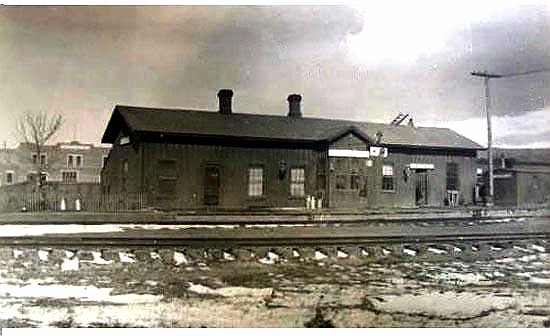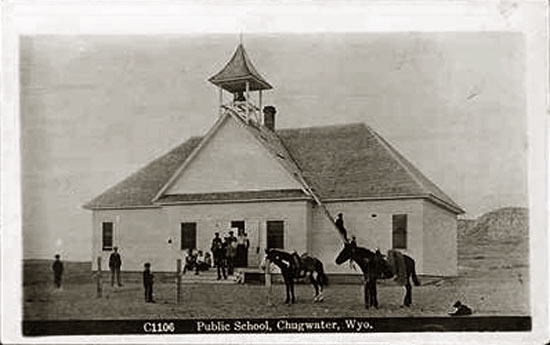
Chugwater Depot, approx. 1917.
Note the hotel in the background. Current photo of hotel toward bottom of page.
Other
early ranchers and settlers along the Chugwater included the Clay brothers, William L. Clay
(1855-1939) and Charles Edward Clay (1838-1905) from Virginia. Charles E.
Clay, a Confederate veteran, served for a time as a sutler's clerk at Ft. Laramie and also worked as
a freighter. He was married to Lulu Fingernail Woman, an
Ogallala Sioux. Following Custer's defeat at
Greasy Grass (Little Bighorn), the
marriage ended in divorce pursuant to Indian custom, with Lulu Fingernail Woman
returning to her people, joining Crazy Horse's Band. The Band surrendered at the
Red Cloud agency on May 6, 1877.
Charles later married Mary Agnes Abney of Cheyenne and was elected to the Wyoming Legislature. He later served as
town marshal in Elma, Washington, where he died of gangene as a result of being kicked in
the groin by a drunk. Two sisters also lived in the
Chugwater-Douglas area. Ann Elizabeth Steele was married to John Raven Steele who worked for a time
for the Swan Land and Cattle Company. Sally was married to Alvah Washington Ayres who owned the
Ayres Natural Bridge, later donated by his son to the state. The Clay name survives as the
name of a street in Chugwater. [Writer's Note: Clay family information courtesy of
Gynger Cook, a descendent of Charles Clay and Lulu Fingernail Woman.]

Chugwater School, undated.
Chugwater, as a town was laid out by
engineers for the Swan Land and Cattle Co. Ltd. in 1886.
The town grew, however, slowly. The Masonic Hall was constructed in 1904 and the Grant Hotel opened its doors
in 1912. It, however burned in 1916 and was rebuilt in 1917. With the boom in Carey Act lands in the
early years of the 20th Century, new settlers came. Most, however left with the drought. Some stayed and by
1919 the town was incorporated.

Chugwater Band, 1915.
In addition to being the headquarters of the Swan Land and Cattle Company,
Ltd., other ranches in the area included the Diamond Ranch, founded in 1880 by New York architect, horse breeder,
and
polo enthusiast George D. Rainsford, the Kelly Ranch, the Huff Ranch, and the Bosler Brothers.
The Bosler brothers, James Williamson Bosler, John Herman Bosler, and George Morris
Bosler, were originally from Pennsylvania and had ranching interests in both
Nebraska and Wyoming. Frank C. Bosler, son of John Herman Bosler, was a
partner of Alexander Swan in the Omaha stockyards and was a stockholder in
the Ogalalla Land and Cattle Co.

1st Street looking north, Chugwater, 2001, photo by Geoff Dobson
The two-story building to the left is
the old hotel, see next photo. Chugwater, unfortunately, is a town where the
main business section has been bypassed by the Interstate just a few blocks away. On the
day the photo was taken, the only sign of life was one lone cowboy who emerged from
a building next to the museum and disappeared. The museum, itself, was closed and the
drugstore across the street from the museum, where one may obtain a key, was not yet open.

View of Hotel, 1st Street, Chugwater, 2001, photo by Geoff Dobson
Note sheep wagon next to one-story building. Although sheep wagons are
traditionally canvas-topped with wooden-spoked wheels with iron tread, many have been
converted to automobile wheels and covered with metal.
Next page, Iron Mountain.
|